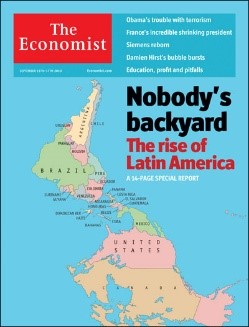At the beginning of 2008, when the financial crisis had already begun to unfold in the United States, Cate Ambrose, president and CEO of the Latin American Association of Private Capital and Venture Capital, stated in a U.S. financial newspaper about the risks for Latin America:
“In late July, as the panic in U.S. credit markets spread to equities, veteran Latin American fund managers initially braced for the worse. Accustomed to sticking out unpredictable cycles of volatility and investor confidence in the past, they could only hope that strong macroeconomic fundamentals – high foreign reserves, low debt, booming exports, solid internal demand and stable inflation and interest rates in Brazil, Chile, Peru and Mexico – would make a difference this time around. In August, as the region’s stock markets tumbled from historic highs and then largely recovered, the broad consensus among analysts and the financial press was that Latin America was better positioned than in the past to weather an international financial crisis.”
 Indeed, Latin American economies were better prepared to face the global financial crisis, and their credit and financial markets largely avoided contagion effects, causing the regional economy to recover quickly in 2010. Even in September of that same year, The Economist magazine declared on its cover: “Nobody’s Backyard: The Rise of Latin America”.
Indeed, Latin American economies were better prepared to face the global financial crisis, and their credit and financial markets largely avoided contagion effects, causing the regional economy to recover quickly in 2010. Even in September of that same year, The Economist magazine declared on its cover: “Nobody’s Backyard: The Rise of Latin America”.
At the global level, the consequences of the financial crisis put the role that governments should assume when their banking systems faced difficulties under the spotlight. And the main factors that attracted attention were moral hazard and the costs of bailing out bankrupt banks at the expense of taxpayers.
As a result, the U.S. Government and several European countries took the step to change their regulatory frameworks to manage bank failures and adopt Effective Resolution Regimes (ERRs), known as bail-in regimes.
In essence, when a bank goes into receivership or bankruptcy, SREs turn to creditors to share losses, either partially or wholly. As a result, governments in these developed economies are now virtually not likely to intervene to rescue their banking systems.
In Latin America, the story is different. As they are not as affected as their U.S. or European counterparts, Latin American banks did not have to be bailed out or request liquidity injections from their governments. Therefore, Latin American governments have seen any urgency in completing the measures agreed with the Financial Stability Board (FSB) to manage bankruptcy proceedings of systemically important banks. Plus, the possibility of a fundamental change in resolution regimes in the region is very low, even in countries with relatively more advanced regulatory frameworks, such as Brazil and Mexico.
The measures taken by many countries, mainly the G20 economies, are aimed at avoiding the rescue of banking institutions at the expense of and loss to taxpayers, altering the economy, the market and the financial system. There are various reasons why measures are not being taken in Latin America to avoid bailing out banks.
These include electoral processes, regime changes, internal political problems, and regulatory and financial flexibility, along with differences in regulatory priorities in each country.
Unfortunately, Latin American economies are more vulnerable today to banking and financial risks than in the years of the financial crisis. Apart from the Argentine crisis and the humanitarian economic catastrophe in Venezuela, the current turmoil in the region is largely due to domestic politics and threats to international trade, but not so much to vulnerabilities in the financial markets.
That said, the lack of adoption of a clear regulatory framework aimed at rescuing the Latin American banking system is an additional area of vulnerability in the region’s economies.
Further Reading:
- Uncertainty, instability and fear haunt a generation of Argentinians
- Investment looks to Latin America, but forecasts are not encouraging
- How can Latin America’s business environment benefit from technological change
- Innovation in Latin America: Potential Goes Untapped Due to Weak Economic Conditions
- Latin America is the World Leader in eCommerce Growth Despite Serious Challenges
 Ricardo Aceves is a Mexican economist specializing in Latin American macroeconomic issues and currently works as a credit risk analyst at CRIF Ratings in Barcelona. He previously worked as Senior Economist for Latin America at FocusEconomics.
Ricardo Aceves is a Mexican economist specializing in Latin American macroeconomic issues and currently works as a credit risk analyst at CRIF Ratings in Barcelona. He previously worked as Senior Economist for Latin America at FocusEconomics.
Latinoamerica21 is a blog about current economic, political and social topics in Latin America that is published within the newspapers Folha de S.Paulo in Brazil, El Observador de Uruguay and Pagina Siete in Bolivia, and will soon be published in other media outlets within the region. The original version of this blog post is available in Spanish: En América Latina, el rescate bancario recaería aún en los contribuyentes.
Follow Latinoamerica21 on Facebook and Twitter.
*Guest blog posts do not reflect the views of FocusEconomics.